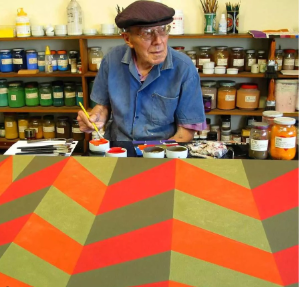Who was Luiz Sacilotto?
Luiz Sacilotto (April 22, 1924 – February 9, 2003) was a renowned Brazilian painter, draftsman, and sculptor associated with Concretism.
In addition to his artistic contributions, Sacilotto also made significant contributions to advertising and architectural design. In 1947, he participated in the Mostra de 19 pintores in São Paulo, which helped boost his prominence in the art scene.
A milestone in his career was signing the Manifesto do Grupo Ruptura in 1952, followed by his participation in the First National Exhibition of Concrete Art, held between 1956 and 1957 in São Paulo and Rio de Janeiro. The Ruptura Group was a collective of Brazilian artists founded in São Paulo, playing a crucial role in the Concrete Art movement in Brazil. The group sought to break away from the artistic traditions of the time and promote geometric and concrete abstract art, as opposed to figurative and subjective art. In the manifesto published the year of its foundation, they outlined their artistic ideas and intentions, criticizing figurative and emotional art while advocating for an approach based on the construction of pure geometric forms.
Throughout his career, Sacilotto had a strong presence in national and international exhibitions, showcasing his work in various settings worldwide. His contribution to Brazilian art was widely recognized, including an homage by Haroldo de Campos in the following poem.
Para Sacilotto / Operário da Luz:
o quadro áureo
de sacilotto –
concreção seis mil
trezentos e cinquenta e um
mil novecentos e cinquenta
e três –
latão tridimensional polido
sabiamente
pelo escultor-operário
de esquadrias metálicas –
deixa que se abram
à superfície
pequenas ventanas triangulares
em relevo
escuras:
o deslumbre da luz aurificada
rebate-se nessas seteiras como em
buracos negros:
ao trânsito do expectador
tudo vibra
tudo entrevibra numa
(pré-op)
cinese dourada
Luiz Sacilotto stands out as one of the key figures of Concretism in Brazil, and his work continues to be studied and admired.

Luiz Sacilotto’s works are known for their geometrically precise compositions, which explore the interactions between form, space, movement, and color, resulting in striking visual effects. Throughout his career, Sacilotto dedicated himself to refining his formal technique and perfecting his creations, experimenting with a variety of materials and artistic processes.
The legacy left by the artist is considered one of the most significant in the Brazilian art scene, as his contributions were essential in solidifying the principles of Concretism, which have influenced artists worldwide. Sacilotto is recognized for bringing innovation and originality to art, leaving a lasting and influential impact on the history of contemporary art.
To read more about the artist, including a chronology of his life and a collection of photographic memories, we invite the reader to visit the Sacilotto website.
Mathematics and the Works of Luiz Sacilotto
Luiz Sacilotto was a master in creating works that explored geometry, abstract forms, and visual dynamism. His connection to Mathematics was evident in his art, especially through the use of geometric transformations. He did not rely solely on intuition for his works. Sacilotto had a meticulous and scholarly approach, grounded in mathematical and scientific principles. Although he was not formally a scientist or mathematician, Sacilotto dedicated himself to the study of mathematical and geometric concepts to create his compositions.
He manipulated basic geometric shapes, such as squares, triangles, and lines, to generate complex patterns and illusions of depth, applying transformations such as reflections, rotations, and translations. Isometric transformations preserve distances and angles, allowing the creation of works with a unique and challenging aesthetic.
Sacilotto’s works often exhibited symmetrical repetitions and visual rhythms, resulting in a sense of movement and dynamism. His ability to explore the mathematical properties of these transformations reflected not only his artistic mastery but also his deep understanding of the underlying mathematical principles. His contribution to Brazilian concrete art goes beyond innovative aesthetics, encompassing the ingenious intersection between art and science, highlighting the influence and importance of Mathematics in his artistic expression.
Sacilotto and his colleagues from the Ruptura Group were deeply influenced by European Concretism. Concretism advocated for art that was objective, rational, and based on scientific principles, as opposed to subjective and emotional art.
Getting to Know Some Works
We invite you to take a Virtual Tour and explore some of the works of this renowned artist.
The exhibition The Vibration of Color was held from August 28, 2021, to October 23, 2021.